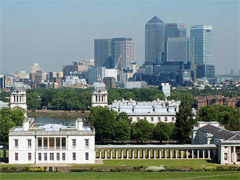


Most Londoners aspire to live in a neighbourhood filled with pretty houses with bay fronted windows, well-kept parks and quirky boutiques, however unfortunately most of these areas are way beyond what most of us can afford. Were they always cracked up to be this good, or did they evolve into the desirable turfs they are today?
Primrose Hill
Then: Once highly desirable, when the railways arrived in the 19th century so did a lot of soot, which understandably put a lot of the area’s wealthy inhabitants off. The grand houses of Primrose Hill became subdivided to provide lodgings for the railway workers, and the fact that many of the local inhabitants were male meant it was a profitable area for prostitutes; there is evidence to suggest there was once a brothel on Gloucester Avenue. The smoke from the railway lines gave Primrose Hill a grey, unhealthy air, with the local primary school being branded the “Smoke School”, until they became electric in the 1960s, alleviating the lungs of many.
Now: Thanks to overpriced delicatessens, greenery and brightly coloured terraced houses, Primrose Hill couldn’t be further away from its mid-20th century incarnation. Gloucester Avenue is now home to a smart hair salon, gastropub The Pembroke Arms and rather more incongruously, the Gorilla Organization; Regents Park Road is inhabited by a dozen cafes and expensive boutiques and the area is one of London’s most sought after, made famous to the rest of the country thanks to residents Kate Moss, Sadie Frost and Co, whose haunt of choice is the too-snooty-for-its-own-good Engineer, also on Gloucester Avenue. In the summertime hoardes of sunseekers gather on the hill to picnic, depleting the local supermarkets of hummus.
\n\nNotting Hill
Then: Notting Hill has gone full circle. In the 19th century it was highly attractive to the upper middle classes who couldn’t afford Belgravia or Mayfair, but over the following 100 years its fortune would transform completely. The large houses that provided homes to families and their servants were divided into smaller lodgings that became severely overcrowded – it was reported that 2,400 people lived in just 140 houses on Southam Street in the 1920s. After World War II, a Mr Peter Rachman, now known as the UK’s most notorious landlord, bought many properties in W11, and he was not averse to using violence to evict tenants and usher in newly-arrived Afro-Caribbean families into tiny spaces for massively hiked rents, as few landlords would take them in at the time. This wave of immigration created such racial tension between the local Teddy Boys and their new West Indian neighbours that police labelled parts of Notting Hill a no-go area. The clashes culminated in the violent Notting Hill Race Riots in August and September 1958; six years later the Notting Hill Carnival had its first event, celebrating Caribbean culture, the diversity of W11 and the abolition of slavery. Reverend Bruce Kenrick, appalled by the slums in his parish founded homeless charity Shelter in 1966; the worst buildings – which had been deemed unfit for human living – were demolished shortly after the arrival of the Westway and the Trellick tower.
Now: In the 80s, during the economic boom, estate agents began to see potential in Notting Hill. The culturally diverse, creative community had much to offer, and once many of the slum buildings had been knocked down it all started to look rather pretty. Young professionals bought up properties, raising the average income of the area as well as the house prices; today it is one of London’s most desirable districts, awash with chic cafeterias and designer boutiques, popular with media types and Tory politicians (nicknamed the ‘Notting Hill Set’, a group that once included David Cameron), while the Carnival is still in full force every year. Plus there is that incredibly twee movie by Richard Curtis. Who would have thought it.
Southwark
Then: Entertainment was provided by the area’s many theatres as well as the rather less salubrious activities of bear and bull baiting, where the unfortunate animals were tied up and attacked by dogs. In her spare time, Queen Elizabeth I loved nothing more than to indulge in a spot of the bloody sport, held in London’s main ring here in Southwark. SE1 was known as London’s Red Light District for several centuries; it was also dangerous as petty crime was common, and was a downtrodden slum throughout the Industrial Revolution. Overcrowding was common - it was typical to find nine people living in one room.
Now: The Tate Modern has put Southwark firmly on the map, giving the riverside district a shiny new lease of life, however as brilliant as they are, the Tate and the South Bank complex can’t change the fact that it is still a poor area for many of its residents. Office blocks, housing estates and new luxury apartments live side by side, the latter creating a huge discrepancy as they are beyond the affordability of many due to their prime location.
\n\nCanary Wharf
Then: Before architects set about conquering the sky line with high rises, this site was occupied by the West India Docks, which saw vessels filled with spices, coffee, cork, spirits and wine travelling between here and the West Indies. The docks were surrounded by 6 metre high security walls and watchmen patrolled at night to protect the area from theft and vandalism, however nothing could protect the warehouses from being practically destroyed during World War II.
Now: The gleaming Canary Wharf construction is one of London’s tallest buildings, and the surrounding area is home to the headquarters of various financial institutions, i.e. Barclays and HSBC. Security is tight in each building to protect from theft and vandalism, although the workers - and the nature of their work - couldn’t be further removed from their 19th century predecessors. The shopping centre caters to the 90,000 people who work here, with a slant towards the upmarket, think Austin Reed and Montblanc rather than factories filled with molasses.


